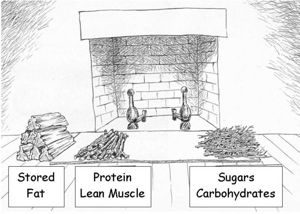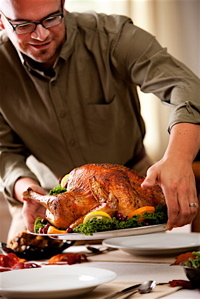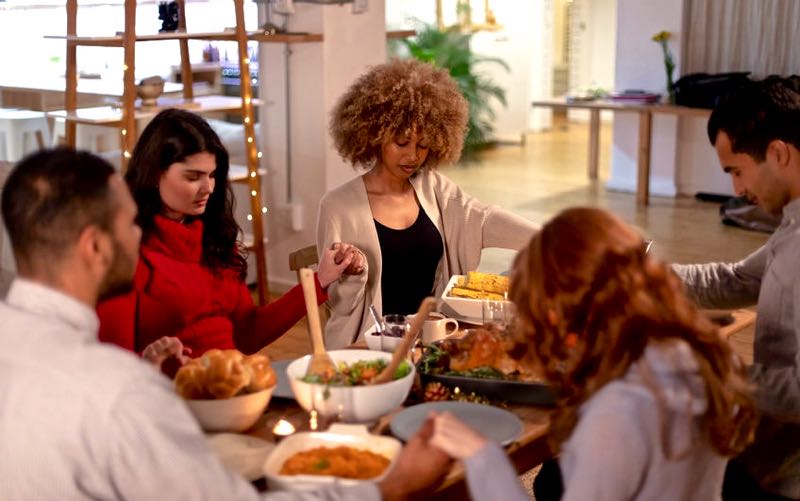 By Charles Burrage, Jr., Ed.D.
By Charles Burrage, Jr., Ed.D.Happy Holidays! A time for all the family, friends, gifts, and …the food. THE FOOD.
How many times have you regretted eating too much during a Thanksgiving, Christmas or other holiday dinner? I know I have. You know the feeling. You sit down at the table, enjoy all the mouthwatering foods made by generations of family members, and you feel fine, happy, even content. But, then as soon as you stand up from the table, all the food you ate “hits bottom” like a ton of bricks. And that same guilty feeling comes over you. The same feeling that snuck up on you last year. That feeling that echoes in your head saying, “Oh no. I did it again. I ate too much.”
Well, make this year different. Let me help you to not just have a happy holiday, but a happy HEALTHY holiday.
 There is a wide range of advice that can be offered for the holiday season on how not to gain weight. I will focus this conversation on fat cells. The more we understand about them, the more we are able to make conscious decisions to manage them and maintain our weight this holiday season. So, let’s talk about fat cells. What they are, what they do and how not to help them.
There is a wide range of advice that can be offered for the holiday season on how not to gain weight. I will focus this conversation on fat cells. The more we understand about them, the more we are able to make conscious decisions to manage them and maintain our weight this holiday season. So, let’s talk about fat cells. What they are, what they do and how not to help them.
Eating to maintain and/or lose weight is not so much about what we eat, but rather, how much and how often we eat. In order to be successful, we can’t feed our fat cells; we need to turn them off. But where do our fat cells come from?
EAT BETTER!
Let us help you find a nutritional coach to support you through the holiday season.
The average person will have developed 6 billion fat cells by the time they enter adulthood. The job of those fat cells is to store fat to help with body temperature regulation, to store certain vitamins (fat-soluble vitamins), and to use as an energy source. Each fat cell has a significant storage capacity. Collectively, we have the potential to fill those fat cells “to the brim”—not a good thing.

Your body is like a fireplace. Especially in the colder winter months – add smaller amounts of healthy logs more often to keep the fire (your metabolism) burning hot!
So, let’s say that your body is like a fireplace (nice winter analogy here for those of us who live in cold states). How do you keep a fire burning? You add more logs to it. This is where so many people get “tripped up” in their nutrition intake or dieting. You must add fuel (food) to keep that fat burning process (metabolism) burning longer and hotter. Don’t deprive yourself of food before the holiday meal because you know that the big family dinner is coming. Likewise, don’t skip meals after your holiday dinner to “make up” for what you ate at the dinner table. Instead, here are some practical steps that you can take to increase fat cell burn and decrease fat cell storage.
Eat breakfast. Eating breakfast increases your metabolism. Remember, your metabolism is always working day and night, slowing down during the night. So, eating breakfast helps to tell your body “I’m awake” and “you need to get working this morning”. So, skipping breakfast while waiting for that big turkey dinner may not be the best idea. Instead, try having a small breakfast, just enough to get that body going and be full until snack time. Forget that Denny’s Grand Slam.
Eat your largest meal earlier in the day (i.e., lunch). Most families already do this on the holiday—the early dinner around 2 or 3pm. That’s great because your body’s ability to burn fat is greater during daylight hours (when you are moving more and haven’t begun to slow down).
AVOID skipping meals, especially lunch. Your fat cells like when you skip a meal because it puts them in charge. They are in charge of your survival process and will start storing fat, as opposed to burning fat the next time you eat.
A VOID overeating. This is the big one for Thanksgiving, Christmas Day, New Years and pretty much every holiday. Some tips to help with this are to drink a glass of water before each meal or you can use this hunger scale to help you better determine when it is time to eat or stop eating.
VOID overeating. This is the big one for Thanksgiving, Christmas Day, New Years and pretty much every holiday. Some tips to help with this are to drink a glass of water before each meal or you can use this hunger scale to help you better determine when it is time to eat or stop eating.
1. You feel weak and light-headed — Your stomach acid is churning.
2. Very uncomfortable — You feel irritable and unable to concentrate
3. Uncomfortable — Your stomach is rumbling
4. Slightly uncomfortable — Your just beginning to feel hungry
5. Comfortable — You’re neither hunger nor full
6. Perfectly comfortable — You feel satisfied
7. Full — A little bit uncomfortable
8. Uncomfortably full — You feel bloated
9. Very Uncomfortably full — You need to loosen some clothing
10. Stuffed — You are so full you feel nauseous
When eating, you should put your fork down at step 5 (for weight loss) or 6 (to maintain weight). You should eat only at step 4, 3, 2, or 1.

Our concept of generous and extravagant eating is getting stuffed – so full you feel nauseous. God’s ‘generous AND extravagant’ is to be satisfied and celebrate the flavor.
Eat smaller meals more frequently. Instead of eating that really big meal with turkey, stuffing, and the works, try to eat less. Then eat a little more in three hours or so.
Reduce the amount of fat in your diet. We should only be consuming 30% or less of our daily calories from fat. To help decrease the fat in our diets we can add some more fruits and vegetables to our holiday table. Delicious and healthier side dishes can make a big difference.
 Set a “stop eating” time. Try not to eat beyond 8pm (or three hours prior to bed time). If you do eat at night, it should be a small, low calorie, low fat snack (e.g., rice cake, fruit, or pretzels). Say no to the cold turkey sandwich at midnight.
Set a “stop eating” time. Try not to eat beyond 8pm (or three hours prior to bed time). If you do eat at night, it should be a small, low calorie, low fat snack (e.g., rice cake, fruit, or pretzels). Say no to the cold turkey sandwich at midnight.
Finally, eat more slowly. Eating slowly allows your other senses to more fully enjoy your food. Look at the colors and textures, smell the aromas, then taste the flavors. Take your time to chew, chew, chew and really enjoy your food.
Learning about fat cells and applying these eating tips will encourage you to better enjoy your holiday dinners this year. Take it from me, it is completely possible to enjoy dinner without over-indulging. I know that I feel better when I choose to eat more responsibly. Plan now to prepare these tasty and healthy nutritious side dishes. Then when you greet your guest this season you can say, “Happy HEALTHY Holidays!”









